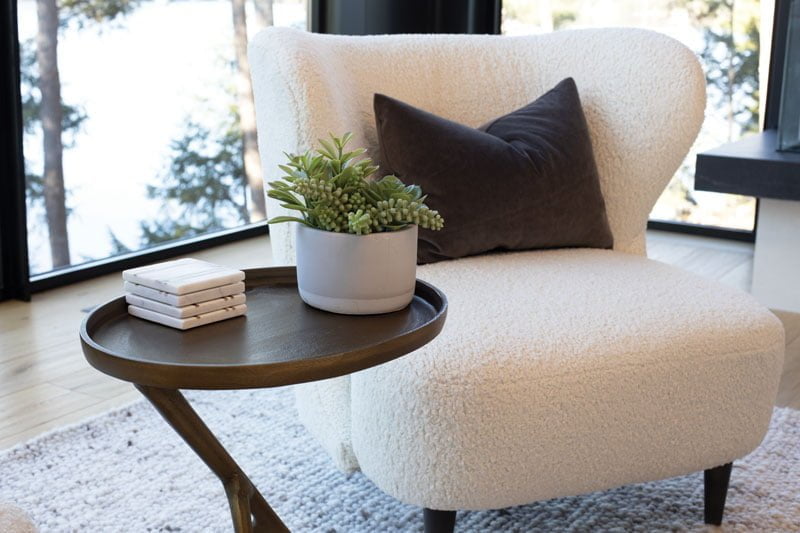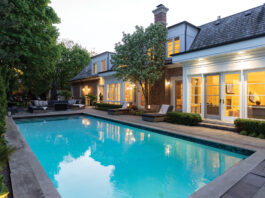By Martha Uniacke Breen
For many cottagers, their favourite room in the house is the great room. Looking out those big windows at the sun glinting off the water, hanging out with the family in the evening, or just stretching out for an afternoon nap – it’s the place we all tend to gravitate to. Tary Roossien and Meredith Parsons, principals with Cassis Design Studio, offer the following advice for making your great room not just great, but cozy too.
Where Do I Start?
Most great rooms or large living areas have room for more than one function, so start by asking yourself what you want the room to include. A comfy space for everyone to relax by the fire? A place for playing Monopoly for hours? A quiet reading nook? Do you have existing furnishings or favourite pieces that you want to put in the space?
The Perfect Backdrop
The colour of the walls is very important for establishing mood – generally speaking, a neutral setting makes the perfect backdrop for favourite colours or textures. (Relying on accessories like pillows, throws and décor pieces to layer in texture and colour makes it easier to change with the seasons or when you want to update your space.) Tary’s go-to favourite shades for walls include Chantilly Lace, a pure crisp warm white; Balboa Mist, with its misty undertone of grey; and Collingwood, a timeless, warm greige (all shades by Benjamin Moore).
Accent walls add personality and are a great way to define a smaller focal area or to create design interest. Consider Naval, a muted navy; Urbane Bronze, a rich chocolate, Mossy Oak, a delicious creamy sage (both Sherwin Williams); or Wrought Iron, a complex off-black (Benjamin Moore).
It’s All in The Planning
It’s good practice to sketch a plan on paper to help establish the flow of your space, positioning the various centres you would like to create. Measure the dimensions of your room and the placement of windows, doors and any other special features. Measure any existing furniture you have as well.
Establish the room’s main focal point – this is its foundational, or anchor, space. For most great rooms, this will be the fireplace, but it could also be a great view or even the TV (or a combination).
Build Your Foundation
Define the boundaries of the anchor space by adding a large, plush rug. This adds a sense of human scale, and helps organize the room logically and visually.
Next, plan out your seating.
These foundational pieces are the most important ones in the room, so they tend to be the most substantial. Sectionals are a great choice, simply because they are so versatile and can be customized to fit the configurations of your seating area.
Another option is to place two matching sofas facing each other, either perpendicular to the fireplace or in an ell-shape, or a sofa facing two chairs.
Depending on the size of your sofa(s), balance the arrangement with the addition of one or two armchairs; if you use just one, opt for an oversize version. Swivel chairs are a really useful option, especially in a large, open room, as they have the ability to swivel and address any area of the room. Finish with a coffee table, side or end tables, and perhaps an ottoman or one or more poufs, for putting your feet up or extra seating.
Supplementary spaces
Once you’ve set up your anchor seating, chances are you’ll have a lot of extra room around the sides. This is where you will add smaller-scale, multi-function spaces to make your great room even more inviting!
Find a corner outside the large seating space – one that entices you to come sit down and chill out for a minute, have a coffee, read a book or get caught up in the latest gossip rags. Think of it as a mini-version of the large seating group: two chairs, end table, floor or table lamp, pillows, poufs and/or a soft throw. Often this becomes the most favourite hang-out of all.
Another popular supplemental space is a games table: four chairs arranged around a square table, perfect for a puzzle or a game of cards.
Lighting
Lighting is incredibly important in any room, but especially in a great room. Keep in mind that most great rooms, with their big windows, will be very bright during the day, but need a lot of lighting at night.
A big chandelier is an effective way to add a statement to your entire great room and further define your foundation seating area, but it’s usually not enough on its own. Add intimacy with table lamps (ambient lighting), whether to illuminate small seating areas, or to add extra lighting in your main seating area. Finally, use task lighting to light specific areas. A floor lamp is an effective way to illuminate book pages for a reader; sconces can add supplemental lighting along the walls.
Finishing Touches
It’s the final touches that give your spaces personality and make a room your own. Fill the room with coziness, layering pillows and throws throughout the spaces, especially in soft materials like alpaca, faux fur, lambswool and cashmere wool blend.
Large-scale artwork adds instant character and interest to a room; no room should be without it.
Layering in natural elements, wood pieces in various finishes, greenery (real or faux), pottery clay vases or stone elements work to neutralize, calm and warm any design.
———
Photo Captions:




———
Design Tips for Creating Great Rooms
1) Rugs
The use of rugs is the easiest and most effective way to define space while creating a warm welcoming feeling. Large rugs work best in large spaces.
Tip: In most cases, your rug shows best when it extends 12-18 inches beyond the front legs of your furnishings.
2) Scale Matters
In large rooms, fewer larger pieces are almost always preferable to a lot of smaller pieces. Opt for pieces that are oversized in length, with fewer but larger seat and back cushions.
Tip: Depending on your sofa size, layer two 22- to 24-inch back pillows; a second layer of two 18- to 20-inch pillows in a contrasting fabric; then top with two lumbar pillows, 16- to 18 by 20 inches.
3) Maintain A Flow
For comfort and to make navigating around the room easier, leave plenty of room to maintain smooth traffic flow between and through each furniture grouping.
Tip: For the most efficient traffic flow between centres, leave a minimum of 18-24 inches, ideally 30-36 inches.
4) The Perfect Balance
When too many visually heavy things are on one side of the room, the entire space looks unbalanced; try to keep both sides fairly evenly matched.
Tip: Sofas tend to take up quite a bit of visual space; balance them with two upholstered club or swivel chairs, or even another sofa.
5) Define Zones with A Sofa Table
Another option for creating multiple seating areas is to section off a large living space with a floating sofa or sectional in the middle of the room, and place a sofa table behind it.
Tip: Your sofa table should be at least half the length of your sofa, and should be lower than the sofa back pillows.
6) The Fine Art of Artwork
Large pieces work best in a large space; a collage of smaller pieces grouped together to fill one space also works very well – try a collection of mirrors, photos or an eclectic group of complementary art pieces.
Tip: Consider adding a console, games table or desk against the wall under artwork; it’s a great way to dress up an empty wall space.






